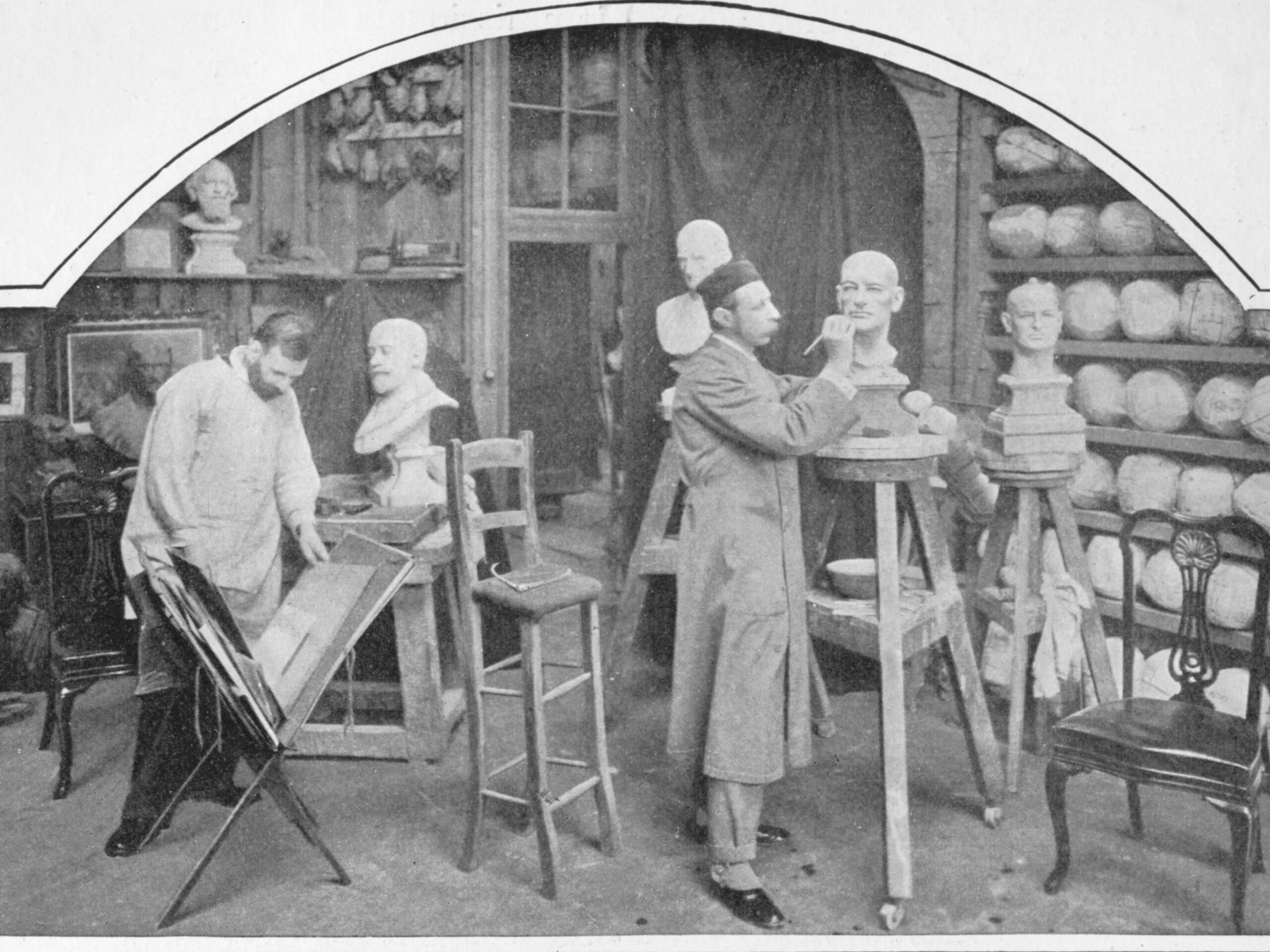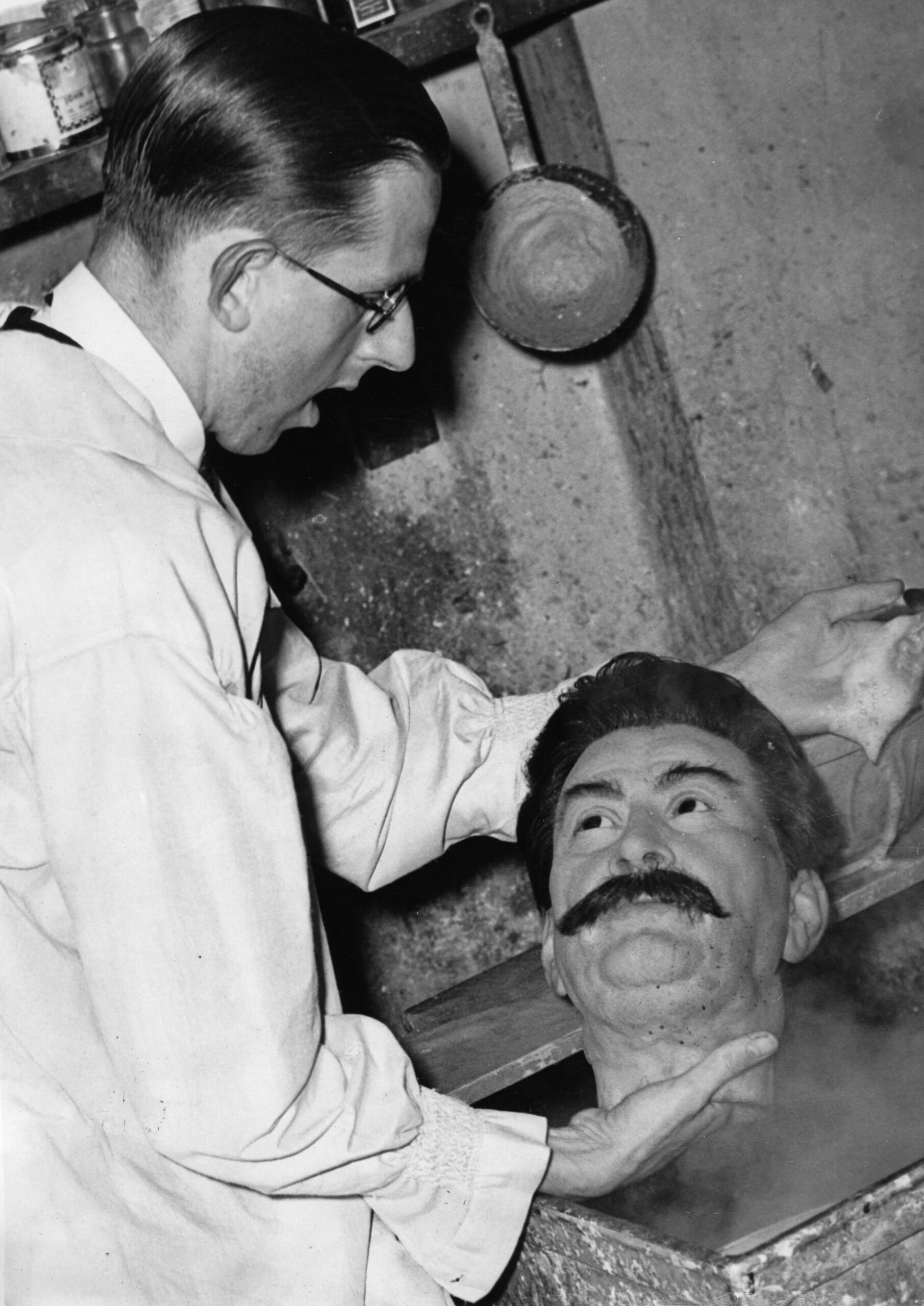- Het wassenbeeldenmuseum Madame Tussauds bestaat al sinds het begin van de 19e eeuw.
- Het museum werd opgericht door Marie Tussaud, die in Versailles werkte als de kunstdocente van de zus van koning Lodewijk XVI.
- De beruchte ‘Chamber of Horrors’, met beelden van moordenaars, verkrachters en dictators, zette het museum echt op de kaart.
- Lees ook: Ooit aten koningin Elizabeth en Tom Cruise er, maar nu ligt Hongkong’s iconische Jumbo Floating restaurant ondersteboven in zee, zonder zicht op redding
Madame Tussauds staat tegenwoordig vooral bekend als toeristische trekpleister, maar was vroeger een subversief museum vol wassen beelden van recent omgebrachte royals, veroordeelde moordenaars en een werkend schaalmodel van een guillotine.
In de afgelopen 200 jaar zijn er veel foto’s en schetsen gemaakt van het werk achter de schermen van Madame Tussauds en daarop is goed te zien hoe de wassen beelden zich in de loop der jaren ontwikkeld hebben.
Van het bescheiden en gruwelijke begin tot de huidige 23 locaties wereldwijd, dit is het verhaal van het wassenbeeldenmuseum Madame Tussauds.
Bekijk foto’s van de 200-jarige geschiedenis van Madame Tussauds
Bekijk foto’s van de 200-jarige geschiedenis van Madame Tussauds
-

Madame Tussauds is named for Marie Tussaud, née Grosholtz, who was born in the French city of Strasbourg in 1761.
By 1777, 16-year-old Tussaud was creating waxworks of famous figures like the philosopher Francois Voltaire under the tutelage of waxworker Philippe Curtius, according to the museum's timeline.
Curtius met Tussaud when she was just a little girl, as her mother worked for Curtius, according to her memoirs, National Geographic reported.
Hulton Archive/Getty Images
-

In 1780, she became the art tutor of King Louis XVI's sister and lived in Versailles, but when the French Revolution began, she moved back to Paris, where she was imprisoned in La Force Prison as a potential monarchist.
She was arrested with Joséphine de Beauharnais, the future wife of Napoleon Bonaparte.
According to Tussaud, she was able to prove her loyalty by making death masks of executed nobles like the king and queen of France and their allies.
Death masks, CNN reported, have been around since ancient-Egyptian times. They are plaster molds of the recently deceased's heads — so, as the story goes, the recently chopped-off heads of the French nobility were sent straight to Curtius and Tussaud and they created lifelike waxworks from them.
In fact, according to her memoir, she sat at the execution site "with the bloody heads on her knees, taking the impressions of their features."
As National Geographic notes, there's no contemporaneous evidence that supports that Tussaud actually came into contact with the heads of her recently deceased employers outside of her own memoirs, which she dictated to her friend, Francis Hervé.
He noted that her recollections were sometimes "in a degree confused and impaired."
However, wax figures of the French monarchy did eventually end up in Curtius', and later Tussaud's, collections.
Photo12/Fondation Napoleon/Universal Images Group/Getty Images
-

By 1795, she had married Franćois Tussaud and inherited Curtius' wax collection. She also officially changed her name to Madame Tussaud. In 1802, she left her husband behind to tour the British Isles with her collection.
Tussaud left her husband and two sons behind to provide for her family by carting her sculptures across the United Kingdom, and she became something of a celebrity, according to the museum.
People were especially intrigued by the sculptures of the French nobility as the country was still embroiled in conflict. The French Revolutionary Wars and the Napoleonic Wars ended in 1802 and 1815, respectively.
Kean Collection/Getty Images
-

Her sons eventually joined her, and they set up a semi-permanent exhibit in 1835 at the Baker Street Bazaar in London.
Her sons, Joseph and François, both became involved in the business when they came of age.
John Thomson/Hulton Archive/Getty Images
-

Tussaud taught her sons everything she knew.
The museum was originally called Madame Tussauds & Sons.
The Print Collector/Getty Images
-

In 1846, she officially established the macabre Chamber of Horrors, which, of course, attracted the most visitors.
According to the museum's timeline, the satirical magazine Punch coined the term "Chamber of Horrors." Up until then, it had just been called the "Separate Room."
Inside the Chamber of Horrors were the most controversial — and most popular — items in the museum, including waxworks of executed politicians and monarchs, murderers, and more. The room even had a working model guillotine.
Hulton Archive/Getty Images
-

At first, it was where the waxworks of the executed French royalty lived, but it evolved to house serial killers and other heinous figures.
According to Atlas Obscura, some criminals who were sentenced to the death penalty even donated their own possessions to Tussaud, just so she'd have the most accurate displays. She'd even show up to criminals' executions to create lifelike death masks.
Tussaud would also purchase memorabilia to display, like the "pram used to transport the dismembered remains of the 1890 Hampstead murder victims," reported National Geographic.
Hulton Archive/Getty Images
-

This is a waxwork of convicted murderer Steinie Morrison.
Morrison was found guilty of murdering Leon Beron, who was found dead in the middle of a London road in 1911 with "S" markings carved into his face, according to a published recounting of his trial.
However, the trial was later criticized, and Morrion's death penalty was commuted into one year of "penal servitude." He died from "semi-starvation" in a prison years later, according to the published record of the trial.
Hulton Archive/Getty Images
-

Some of the wax figures became so popular they'd be guests of honor at other events. A sculpture of murderer Charles Peace was even transported to a meeting of London's "Crime Club" to be the honorary president.
True crime has always been a fascination, and even in the early 1900s, there were societies like the Crime Club, which rented out the wax figure of Charles Peace, a convicted murder from Sheffield, England, to be its guest of honor at a meeting.
According to The Kiveton Park & Wales History Society, Peace was executed in 1879 after evading capture for two years after murdering Arthur Dyson in his own home. He later admitted to more burglaries and at least two more murders before his death.
Imagno/Getty Images
-

Historical figures also made their way to the Chamber of Horrors, like Adolf Hilter.
The Hitler statue was once doused in red paint in 1933, according to The New York Times, by a group of men and women who also hung a sign from his neck proclaiming him a "mass murderer."
Controversy has continued to follow Hitler waxworks. In 2008, a Hitler statue was beheaded in Madame Tussauds' Berlin location, reported NBC.
AFP/Getty Images
-

The Chamber of Horrors remained popular until it closed in April 2016, but it didn't stay gone for long. It reopened in 2022.
According to Blooloop, a website for attractions professionals, the Chamber of Horrors closed in 2016 to make room for a more "family-friendly" exhibit focused on Sherlock Holmes.
But in time for Halloween 2022, the Chamber of Horrors returned.
"Crime and horror have been embedded in the history of Madame Tussauds London since its inception," Zoe Louca-Richards, historian and archivist, told Blooloop. "Madame Tussauds London's archive houses a significant collection of historical artifacts, which help tell the story of some of the capital's darkest crimes."
brandstaetter images/Getty Images
-

Madame Tussaud died in 1850, leaving her son Joseph in charge. This waxwork is a self-portrait completed in 1942. It's still on display at the original London location.
According to her great-grandson's book about her life, her last words were spoken to her sons: "I divide my property equally between you, and implore you, above all things, never to quarrel."
ullstein bild/Getty Images
-

The Tussauds were involved in the museum until 1889, when Madame Tussaud's great-grandson John Theodore sold the company — though he remained as manager and chief artist until his death in 1943.
John Theodore published a book about his family business, "The Romance of Madame Tussaud's," in 1920.
Madame Tussauds is currently owned by Merlin Entertainments, which is in turn owned by private-equity group Blackstone. Blackstone acquired Madame Tussauds in 2007 for $1.9 billion, Bloomberg reported at the time.
General Photographic Agency/Getty Images
-

In 1884, the museum's location was moved to London's Marylebone Road where it stood until 1925, when it was destroyed by a fire.
All the waxworks and costumes that were left inside were destroyed.
Museum of London/Heritage Images/Getty Images
-

Police attempted to save as many waxworks as they could from the 1925 fire.
Thankfully, most of the old molds were preserved and the Tussaud family was able to recreate their most famous wax figures.
Davis/Getty Images
-

It took three years to reopen after the 1925 fire. The museum was restored by 1928, with additions of a restaurant and a movie theater.
It was again damaged by a German bomb during World War II in 1940, which destroyed the movie theater and 352 wax heads — though, ironically, not the Hitler statue.
A planetarium replaced the cinema, the first in the British Commonwealth, in 1958.
General Photographic Agency/Getty Images
-

As the museum grew in popularity, more and more celebrities were represented. This is a waxwork of then-Princess Elizabeth in 1928.
The then-princess was just 2 years old when she was first immortalized in wax. Over the next 90 years, 23 wax figures were made of Queen Elizabeth II to depict her over the course of her life.
According to Madame Tussauds, she sat regularly for the wax artists until 2001.
A. R. Coster/Topical Press Agency/Getty Images
-

Here's professional soccer player Tom Parker sitting opposite himself and John Tussaud in 1930.
It must be disconcerting to stare at such a lifelike replica of yourself, kind of like the uncanny valley.
J. Gaiger/Topical Press Agency/Getty Images
-

The wax-sculpting process can be a tedious one.
This photo, taken circa 1950, depicts part of the wax-molding process — part of working with wax figures means you have to get used to seeing disembodied wax faces on the daily.
George Pickow/Three Lions/Getty Images
-

Today, it takes three to four months and at least 10 people to create a wax figure.
According to Madame Tussauds, 500 measurements are taken of the subject's body to ensure the highest accuracy, and it costs over $264,000 to create just one figure.
Console/Topical Press Agency/Getty Images
-

Julie Andrews, then best known for starring in "My Fair Lady" on Broadway, sat to get her head measured in 1958.
Now you can see a model of Andrews as Maria from "The Sound of Music" at Madame Tussauds' Vienna location.
George Greenwell/Mirrorpix/Getty Images
-

John Lennon and George Harrison were photographed trying to pick the perfect eyes for their wax counterparts in 1964.
Not even Madame Tussauds was immune to Beatlemania.
Mirrorpix/Getty Images
-

Almost 50 years later, Harry Styles and the rest of One Direction were subjected to the same measurements.
There have been multiple Styles waxworks since.
Madame Tussauds/Getty Images
-

For the last 200 years, people have been captivated by Madame Tussauds and her ever-growing collection of wax celebrities and controversial figures.
This is Caryl Chessman, who was executed in the gas chamber in San Quentin prison in 1960 — he was within minutes of being saved by his lawyer, whose motion to stay the execution was approved by a judge moments too late, according to Crime Magazine.
While the Chamber of Horrors and exhibits like it might be controversial, they've proven to be a great success.
There are now 23 Madame Tussauds locations all around the world, from Dubai to Singapore to Nashville to Hollywood to Sydney. According to the museum, 10 million people visit each year.
Express/Archive Photos/Getty Images
